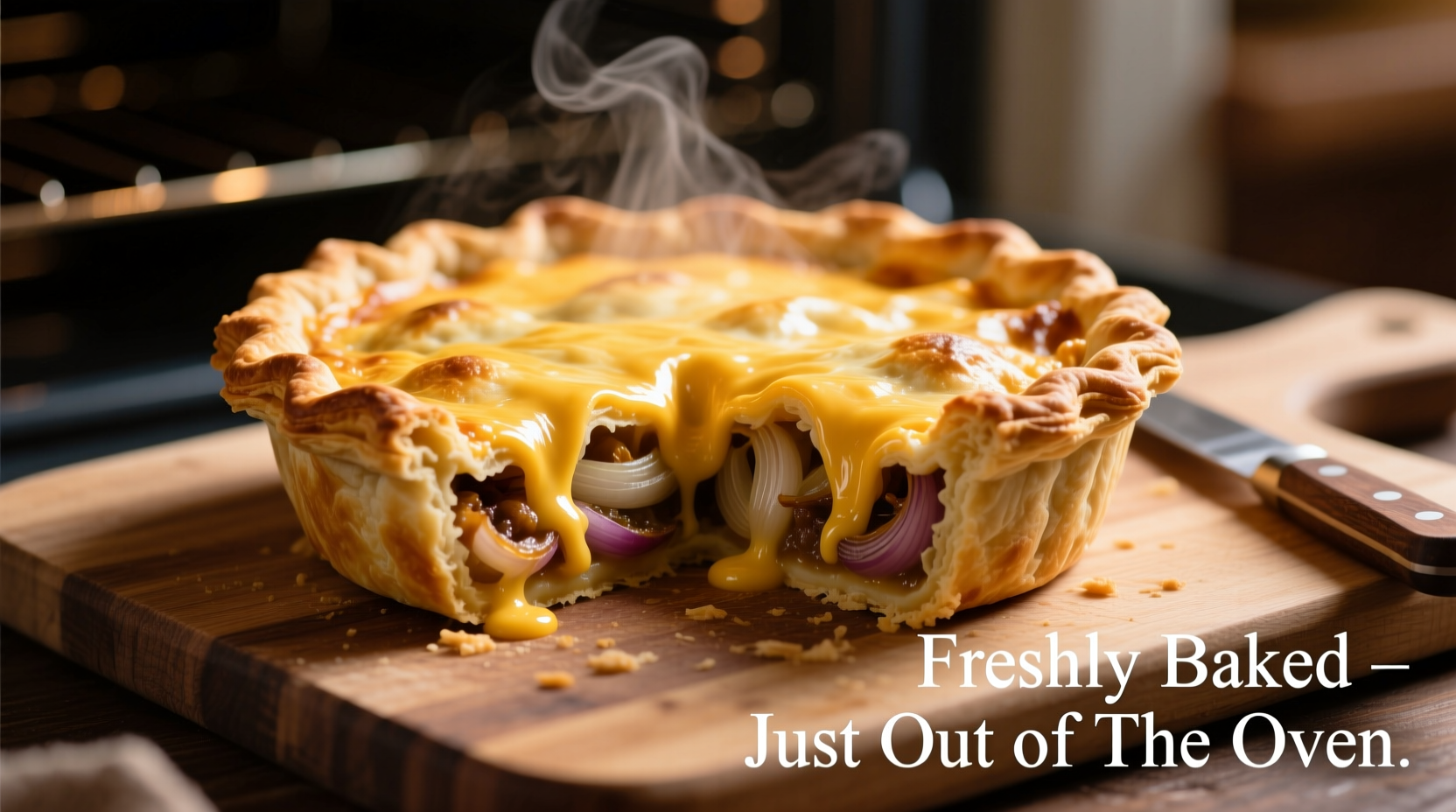Cheese and onion pie is a classic British comfort food featuring a flaky pastry crust filled with melted cheese and caramelized onions. The traditional version uses sharp cheddar cheese and yellow onions cooked slowly until sweet, encased in shortcrust or puff pastry. This vegetarian-friendly dish typically requires 45-60 minutes to prepare and bake, serving 4-6 people as a main course.
There's nothing quite like the aroma of a freshly baked cheese and onion pie filling your kitchen. This beloved British staple has evolved from humble pub fare to a sophisticated centerpiece at dinner parties worldwide. Whether you're a beginner cook or seasoned chef, mastering this dish delivers impressive results with relatively simple techniques.
The Evolution of a British Classic
Cheese and onion pie traces its origins to 19th century England, when resourceful cooks began repurposing leftover cheese and vegetables into satisfying meals. Originally served in working-class pubs as an affordable alternative to meat pies, the dish gained popularity during World War II rationing when meat was scarce. By the 1970s, it had become a standard offering at British football stadiums and school cafeterias. Modern chefs have elevated this humble dish with artisanal cheeses and creative pastry techniques while maintaining its comforting essence.
Choosing Your Perfect Cheese Blend
The cheese selection makes or breaks your pie. While traditional recipes call for sharp cheddar, experimenting with cheese combinations creates distinctive flavor profiles. Consider these options for your next cheese and onion pie with puff pastry creation:
| Cheese Type | Flavor Profile | Best Used For | Melting Quality |
|---|---|---|---|
| West Country Farmhouse Cheddar | Sharp, nutty, complex | Traditional British version | ★★★☆☆ |
| Double Gloucester | Mild, buttery, slightly sweet | Creamier texture | ★★★★☆ |
| Red Leicester | Fruity, mellow, earthy | Vibrant color contrast | ★★★☆☆ |
| Wensleydale with Cranberry | Tangy, sweet, complex | Festive variations | ★★☆☆☆ |
Mastering the Onion Foundation
Properly cooked onions form the flavor backbone of any exceptional cheese and onion pie recipe. The secret lies in patience—cook your onions slowly over medium-low heat for 25-30 minutes until they reach a deep golden brown. This caramelization process develops natural sweetness that balances the cheese's saltiness. For best results, use yellow onions rather than red or white varieties, which contain less sugar. Add a pinch of sugar and teaspoon of balsamic vinegar during the final 5 minutes to accelerate caramelization without burning.

Your Step-by-Step Preparation Guide
Preparation Phase: Setting Yourself Up for Success
Gather these essential tools before starting your cheese and onion pie from scratch: a 9-inch pie dish, rolling pin, sharp knife, box grater, and heavy-bottomed skillet. Chill your pastry ingredients and tools for at least 30 minutes—cold ingredients create flakier crust. Measure all components precisely; baking is a science where small variations affect results. Have your cheese grated and onions sliced before heating your skillet.
Cooking Phase: Building Flavor Layers
Begin by cooking 4 large sliced onions slowly in 2 tablespoons of butter and 1 tablespoon of olive oil. Season with salt to draw out moisture. After 15 minutes, add 2 minced garlic cloves and continue cooking until deeply caramelized. Remove from heat and cool slightly while preparing your pastry. For the filling, combine 300g grated cheese with the cooled onions, 1 egg beaten with 2 tablespoons cream, and season with black pepper and a pinch of nutmeg.
Assembly Phase: Creating the Perfect Structure
Roll your chilled pastry to ⅛-inch thickness. Line your pie dish with two-thirds of the pastry, leaving an overhang. Fill with the cheese and onion mixture, ensuring it's evenly distributed. Cover with the remaining pastry, crimp edges, and cut steam vents. For that professional touch, brush with egg wash and chill for 15 minutes before baking at 200°C (400°F) for 30-35 minutes until golden brown.
Avoiding Common Pitfalls
Even experienced cooks encounter issues with cheese and onion pie. A soggy bottom crust typically results from insufficiently cooked onions—always drain excess liquid before adding to pastry. If your filling separates during baking, you've likely used too much liquid in the mixture; the egg and cream should just bind ingredients without making it wet. For optimal cheese distribution, reserve 25% of your grated cheese to sprinkle between the onion layers rather than mixing everything together.
Serving and Storage Guidelines
Cheese and onion pie shines as a standalone meal but pairs beautifully with a crisp green salad and crusty bread. Allow the pie to rest for 15 minutes after baking—this crucial step lets the filling set for cleaner slices. For make-ahead convenience, prepare the filling and pastry separately up to two days in advance, assembling just before baking. Leftovers keep well refrigerated for 3-4 days and reheat beautifully in a 175°C (350°F) oven for 15-20 minutes. Freezing the unbaked pie works well for longer storage—wrap tightly and bake from frozen, adding 15-20 minutes to cooking time.
Popular Variations to Explore
Once you've mastered the classic cheese and onion pie with cheddar, experiment with these adaptations. Add 100g cooked spinach for a vegetarian protein boost. Substitute puff pastry for shortcrust for a lighter, flakier texture. For a gourmet touch, incorporate caramelized shallots alongside the onions. Some bakers add a tablespoon of whole grain mustard to the filling for complexity. The Welsh version, Caws a Cenin Pie, includes leeks instead of onions and Caerphilly cheese. Remember that authentic cheese and onion pie filling recipe proportions maintain a 2:1 onion-to-cheese ratio by volume for balanced flavor.











 浙公网安备
33010002000092号
浙公网安备
33010002000092号 浙B2-20120091-4
浙B2-20120091-4